California Nebula in Hydrogen-alpha
The California Nebula (NGC 1499) in the Constellation Perseus is relatively close to us, about 1000 lightyears away in the Orion Arm of our galaxy (Milky Way), and it's roughly a 100 lightyears in length, so what you see here, top to bottom, is about 600 trillion miles of ionized hydrogen. NGC 1499 is a good-sized emission nebula, about 2.5° in length from our view on Earth. To put that into perspective, a full moon is 1/2°, so the California Nebula is about 5 full moons long in the sky.
Imaging session notes: 50 x 240 second subs, stacked in DSS, processed in PS 2021. SkyWatcher EQ6-R Pro mount, William Optics GT81 Apochromatic Refractor 392mm at f/4.7, ZWO ASI1600MM-Pro monochrome camera, Astronomik 6nm Ha filter, Controller: Raspberry Pi 4 4GB / 128GB running INDI/KStars/Ekos.

Posted November 10, 2020
Try out the new pier with some imaging
The weather has not been cooperative but I have set up the SkyWatcher EQ6-R Pro on the new backyard pier, along with the William Optics GT81 and my narrowband imaging train. I'm using the latest (v1.54) Stellarmate for these tests, but not in Stellarmate mode (not using the app). I'm remoting into the machine, running on a Raspberry Pi 4 4GB board with 128GB, and just running KStars/Ekos there. I used the QHY Polemaster on the Mate to polar align, and that was easy. My one imaging test so far with NGC 281 (Sh2-184) the Pacman Nebula in Hydrogen-alpha worked well enough with 7 240-second Ha subs stacked in DSS and processed in Photoshop 2021. No calibration frames. There wasn't time before the clouds drifted in. My next test is to use SharpCap Pro's Polar Alignment functions, and see where that gets me.
Some shots from the the night of November 7:



Posted November 9, 2020
Updated William Optics SpaceCat 51 setup with Autofocus
If you have seen some of my videos and blog posts on the Cat you know I have two astro camera trains, one color, one narrowband. This one consists of a ZWO ASI1600MM-Pro mono, ZWO ASI filter wheel with Astronomik 6nm HA, OIII, and SII filters, along with a CLEAR in slot one, and a near-IR filter in the fifth position.

Another reason I want to show off this setup is the single-power wire config. Everything else is on the scope or controlled wirelessly--for example, the iOptron CEM25P or my Orion Atlas can be controlled by Ekos through wifi or bluetooth.

I shot some beautiful color images earlier this year and late last. I'll show M31 and a couple others later, but with that color setup I was running multiple power cables and a heavy duty USB cable to the scope, and although this is setup, which I will try out as soon as it clears up, looks a bit cluttered, I want fewer cables running from cameras, controllers, focusers, and other devices. Fewer cables reduces the chance of one of them hanging up on the mount, or swinging just enough with a gust of wind to throw guiding off.
The controller--the aluminum box on the left side is a Raspberry Pi 4 with 4 gigs, running INDI, Ekos, KStars. I remote into this just like I would with with Windows to run Sequence Generator Pro. The only difference is this box is mounted to the scope. I am looking at running my Windows-based astro controller and sequencer stuff on a similarly small single board computer, and then I can just swap out one system for another. 4 USB ports on the Pi, though, really does make things easier.

I am using the DeepSkyDad AF3 belt-drive autofocus, with the helical focuser timing belt ring made for the cat. I think Pavle at DeepSkyDad sells the components by themselves if you're interested in doing something like this. The rest of it is made up of various SmallRig camera rails, clamps, and support pieces.

I also have GPS via a USB dongle to automatically get accurate date, time, longitude, latitude, and altitude for Ekos and KStars.
Of course, as is typical, I'm ready to go and the weather's supposed to cloud over in the next couple hours, right around sundown. Hmmm. It's almost as if there's a conspiracy.
I don't normally need dew control this time of year and maybe halfway through the summer, but I will add a dew heater when I need to, but still keeping with a single 10 - 15 amp 12 volt dc line in, and I'll see if that's enough to drive all the devices. Planning this stuff out is half the fun.
That white rectangular shape under the Raspberry Pi is a DC step down converter, taking 12v dc to 5v at 5 amps. The Raspberry Pi 4s need a bit more current then the older 3s.

Before I pack it up, I want to show off a couple astro images from a couple different imaging runs.
The first is the Rosette Nebula NGC 2237 in Monoceros, a large circular HII region. The open star cluster NGC 2244 has formed out of—and continue to form out of—the Rosette's abundance of hydrogen and other materials. NGC 2237 is about 5000 lightyears away from us, and it's about 130 lightyears across. That's Sh2-280 on the right, a dim diffuse nebula. Another one from my backyard with the William Optics SpaceCat 51 250mm FL APO refractor, iOptron CEM25P EQ mount, ZWO Astronomy Cameras ASI071MC cooled color camera, Celestron UHC/LPR filter. 13 x 2-minute exposures, 4 x 8 minute exposures.
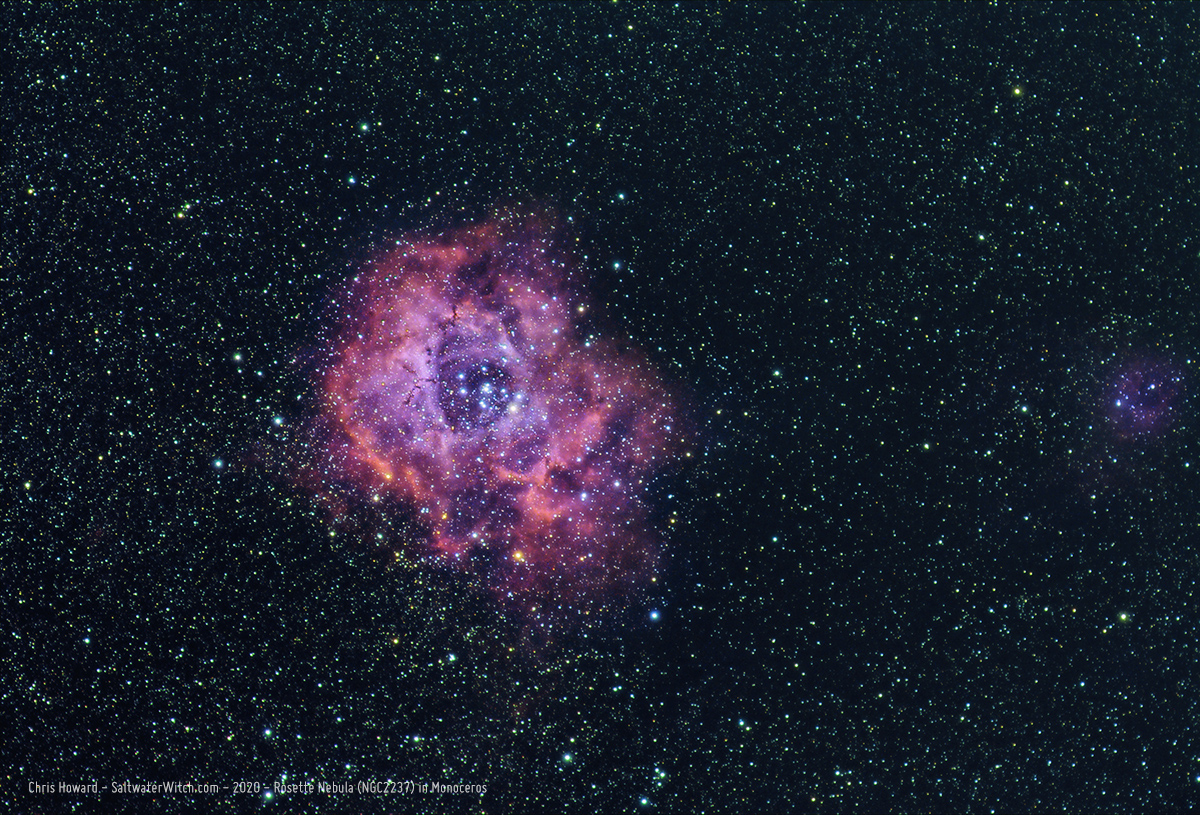
One more from my backyard with the WilliamOptics SpaceCat 51 refractor and the ZWO ASI071MC camera: the grandest of the galaxies, Andromeda, M31. Of course, there are millions of incredibly beautiful and strange—and even downright bizarrely structured galaxies out there in the universe, many within normal telescope distance, but in my opinion they don't come close to M31. You could argue the Pinwheel Galaxy (M101) is in the running because it is so perfectly positioned from our perspective, a wonderful top-down view of a spiral galaxy. But Andromeda is like the Platonic ideal of a spiral galaxy. M31 also happens to be our largest galactic neighbor. So at 2.5 million lightyears away, it's close by. It's also much larger than M101, with a trillion stars and a hundred thousand lightyear diameter. This is probably one of the first objects an astronomer or astro-imager in the northern hemisphere is going to view or capture. You can see it without a telescope on a clear dark night. Andromeda Galaxy was first documented by astronomer 'Abd al-Rahman al-Sufi in 964. He described it as a "nebulous smear" in his famous Book of Fixed Stars, which is exactly what it looks like without a telescope—and if you know where to look. It's in the constellation Andromeda, so that should get you pointed in the right direction if you're inclined. Note: This image is a combination of RGB color and near-infrared frames I captured earlier this year and late last year. I'm just getting around to processing them!
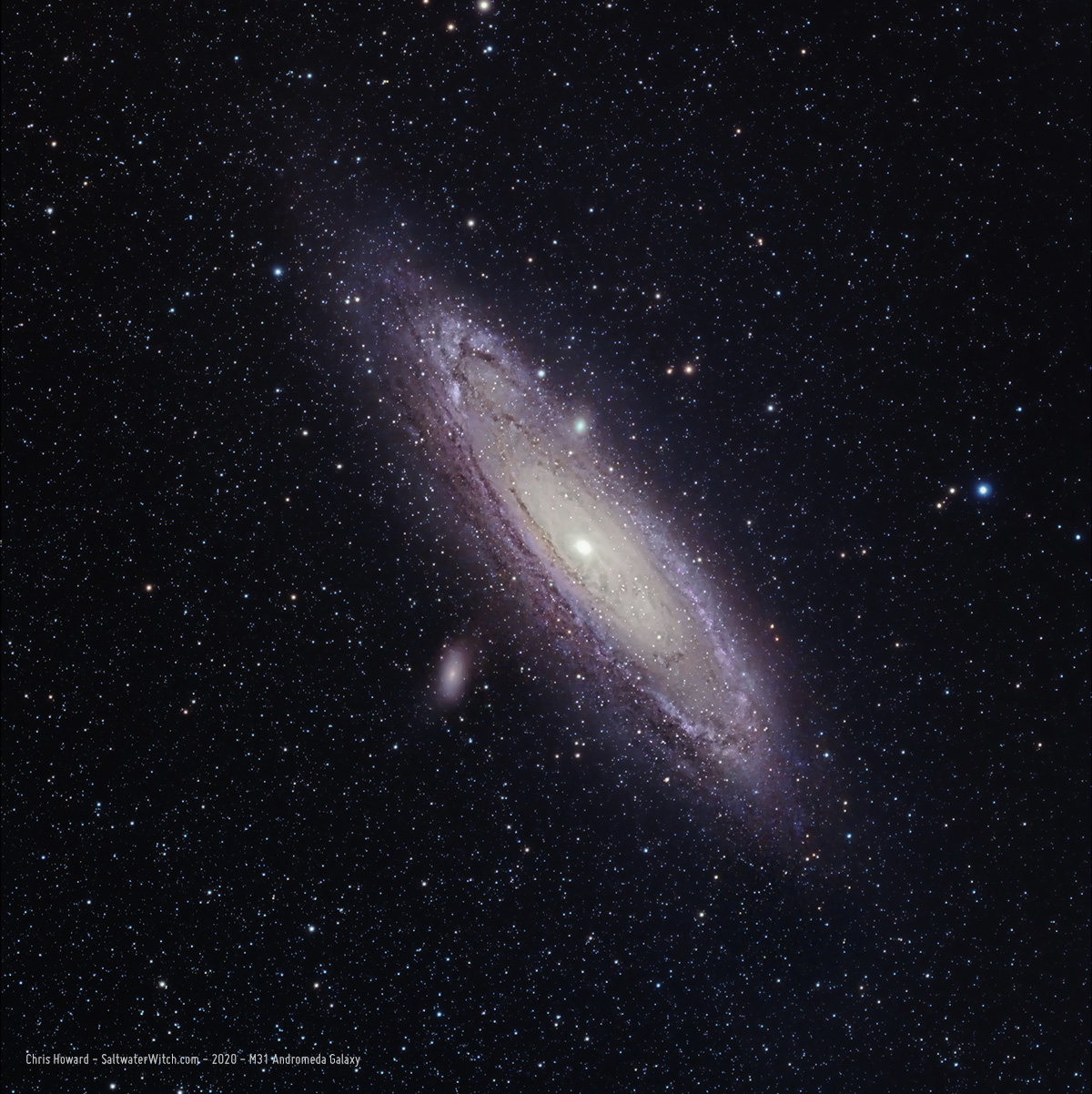
Okay, so that's it for now. Just a quick walkthrough of my narrowband rig with the William Optics Space 51 and autofocus. And with a single cable running to the setup. So, this setup really is plug in the power, polar align, and start taking subs.
Well, we'll see how easy it is once we get some clear night sky!
Posted April 26, 2020
iOptron SkyGuider Pro Test 2
Cygnus region of the Milky Way, with NGC 7000 North America nebula at the bottom left, the Sadr Region in the center, and it's crazy how much of the Veil Nebula showed up--that's the ring of wispy, mostly white nebulosity on the right toward the bottom. The reddish/pinkish areas are mostly clouds of hydrogen gas, while the pale cloudy areas are mostly stars--so many stars. Our galaxy contains somewhere between 150 and 250 BILLION stars. 3 x 120 sec exposures, Nikon D750 85mm f/5.6, on an iOptron SkyGuider Pro tracker.
The SkyGuider Pro has iOptron's standard polar scope and reticle, and by "standard" I mean so much easier to use than just about any other polar scope on the market--that I've used anyway. With just a simple alignment, using the SkyGuider's polar scope, I was shooting 2 and 3 minute exposures. This little tracker is amazingly simple and powerful. At some point I will start testing my color wide-field rig with the William Optics ZS61 and ZWO ASI071MC camera, but for now I want to get used to the SkyGuider, and I'm using my good old Nikon D750 full frame DSLR (unmodified). And you can see this setup produced some decent images to stack.

Posted August 25, 2019
The Wizard and the Soul
I captured almost 5.5 hours of OIII and SII data on NGC 7380 (Sh2-142) the Wizard Nebula and star cluster in Cepheus, along with a full set of narrowband frames for IC 1848 the Soul Nebula in Cassiopeia. I timed things well enough that I captured 20 subs each of Ha, OIII, and SII for the Soul before the earth rotated into early morning. Not a ton of data, but enough to process and see how it looks--not bad, in my opinion. My camera rotation is almost 90º off, almost vertical against the long side of the sensor, but I cropped the nebula to a square so you don't have to see how silly that looks.
I captured the Ha data for the Wizard Nebula early in July, and now I have enough to process in SHO (Hubble Palette) that's where we map the three bandpasses, sulfur (SII), hydrogen (Ha), and oxygen (OIII) to RGB, Red, Green, Blue to make up a color image.
Here's NGC 7380, Sharpless 2-142, Wizard Nebula:
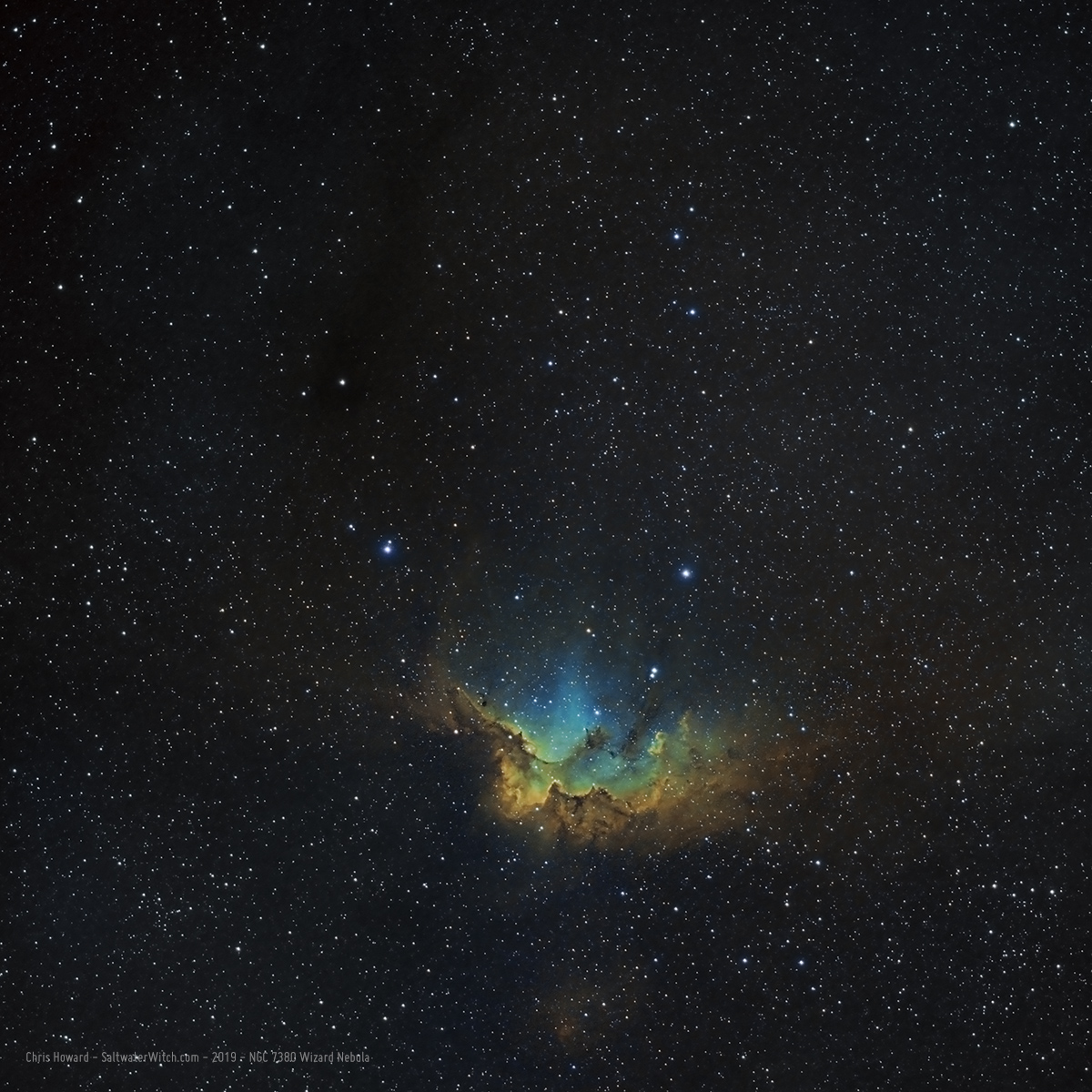
IC 1848, the Soul Nebula:
I don't know if I succeeded but I was trying to get more hydrogen green back into the arrangement. Most of the nebula is hydrogen--just going off the signal in the Ha frames compared with the OIII and SII data. The rims of both regions of IC 1848 are thick with sulfur--red and green gets us that golden brown, but I think the processes, filters, actions typical for astro imaging go too far in reducing green in the images, bending it more toward blue. This does have the benefit of bringing out oxygen, which is nowhere near as plentiful as the blues I see in most SHO/Hubble Palette images. That's just what everyone's come to expect from a "Hubble" image. On the other hand this is one of the coolest aspects of the hobby, the ability to go back and re-processes your data, because you have new or improved processing tools or skills, a new set of data, or simply because you want to experiment with color allocation.

I woke up around 3:30 am and went out to check on the night's imaging run. I was in the middle of the sulfur2 frames when I took this shot with the Nikon: the William Optics GT81 APO refractor pointed at Cassiopeia (top left), actually just below it, which is where you will find IC 1848, the Soul Nebula. Just so you are aware, this is all automated--slewing, plate solving, focusing, filter rotation, and image capture. Once I plot and schedule an imaging run, the last place I want to be is near the telescope where the slightest motion in the ground can ruin a good 5-minute exposure. I was just out there to look at the beautiful sky, and take some crappy blurry photos of my astro gear against the starry background.
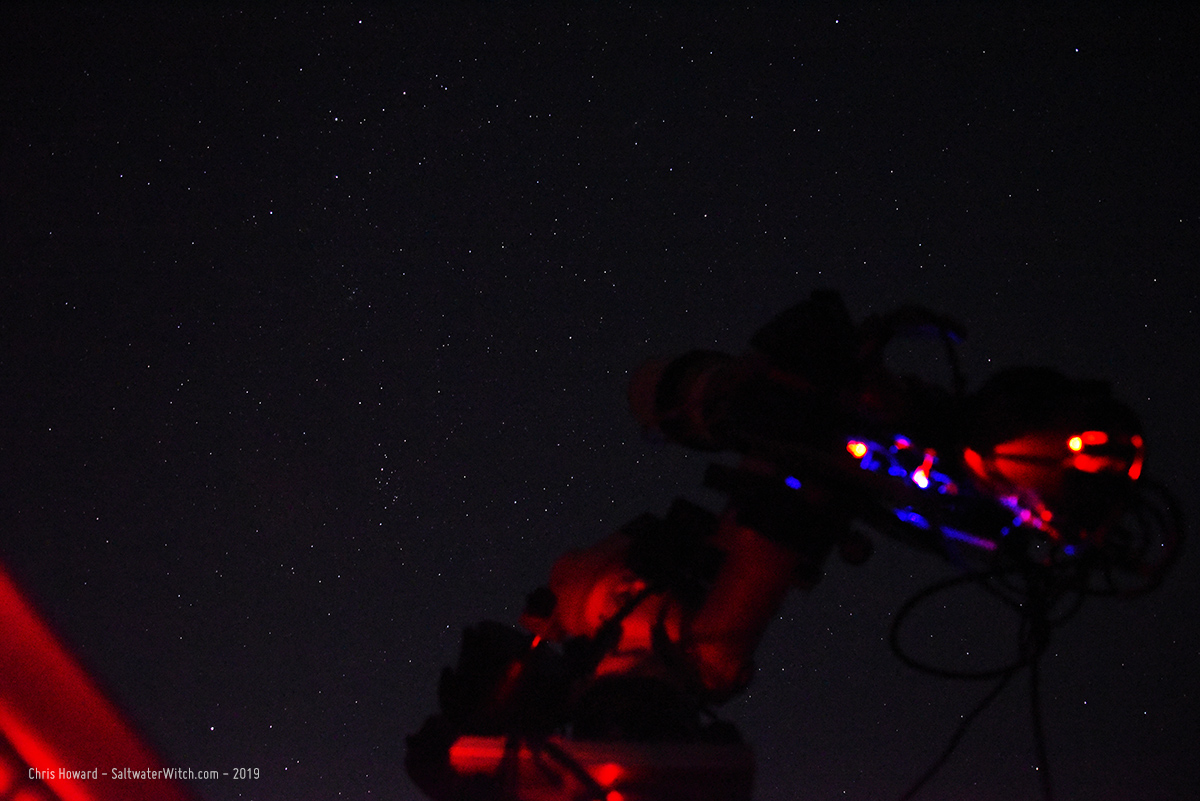
Posted August 2, 2019
NGC 281 Pacman Nebula
NGC 281 Pacman Nebula - I'm finally getting around to processing a bunch of data I gathered over the last month and a half. Pacman is one my favorite nebulae in Cassiopeia. I love that it's out on its own, surrounded by cold dark space and a field of stars. NGC 281 also has an impressive set of Bok Globules, those dark gaseous knots drifting in front of the bright blue and gold (oxygen and hydrogen). And that's Achird (eta Cassiopeia) at the bottom left, a variable double star a little under 20 lightyears away. Damn, that's nearly close enough to visit--with the right technology.
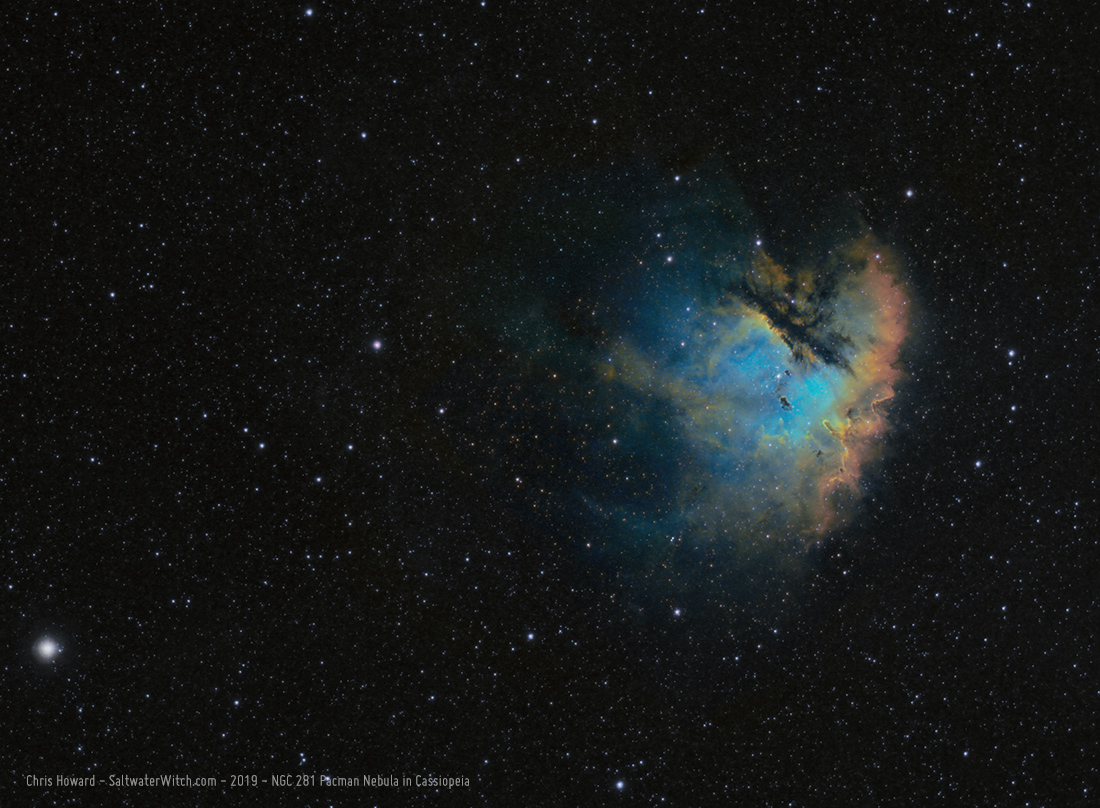
Another one of the Pacman Nebula NGC 281, with narrowband data I started taking in early June. You can really see the Bok globules, those little lumps of dark dust and gas standing out near the center and backlit by the bright emission of the Pacman. https://en.wikipedia.org/wiki/Bok_globule
Imaging notes: William Optics GT81 at f/4.7 with WO 0.8x Flat6A II, Astronomik Ha, OIII, and SII filters, Moonlite focuser, ZWO ASI120MM OAG, Imaging camera: ZWO ASI1600MM Pro cooled mono on an iOptron CEM25P mount. Stacked in DSS, processed in PS CC 2019.
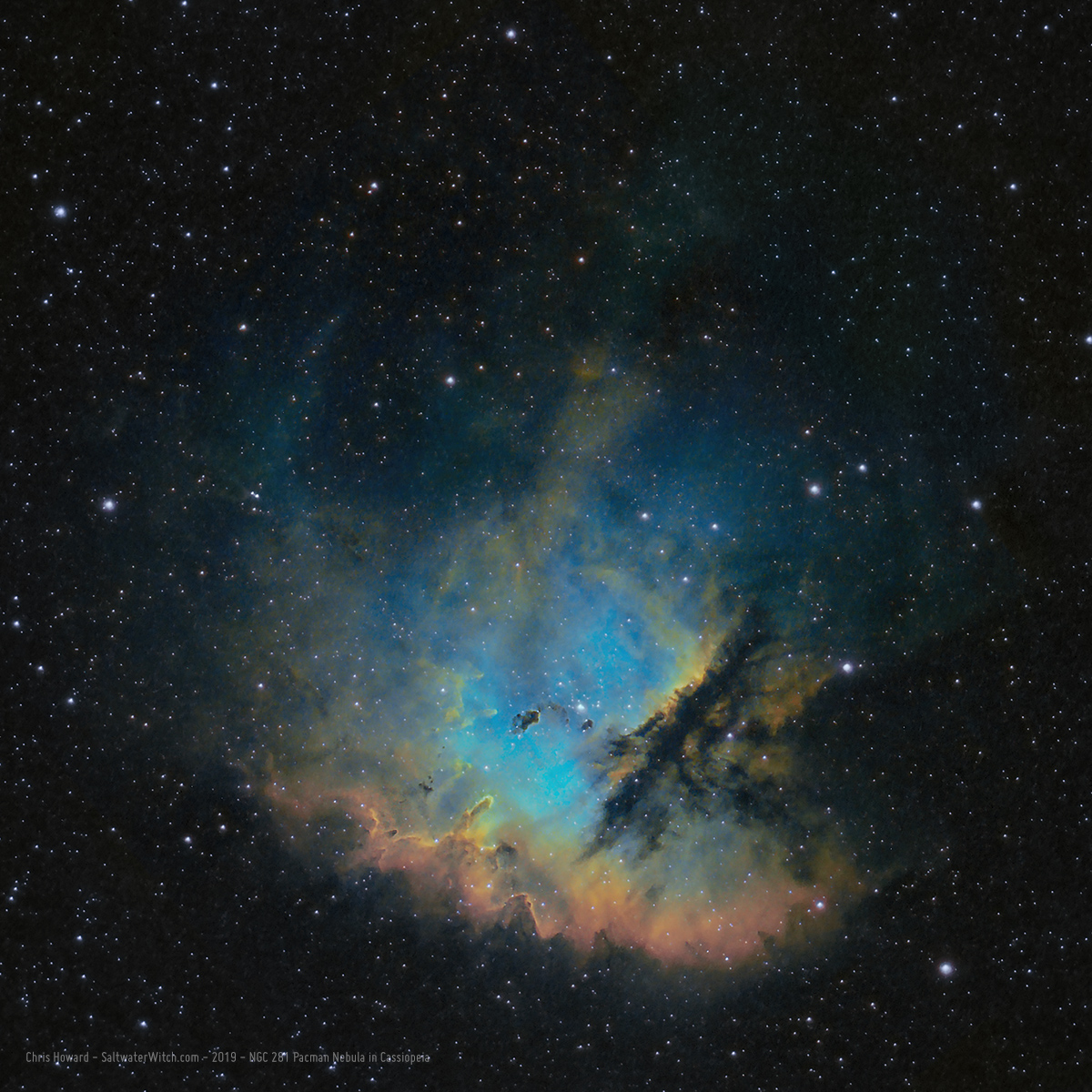
Posted July 29, 2019
Pelican Nebula ( IC 5070 and IC 5067)
Another one from my June 8th narrowband imaging run through the constellation Cygnus. The Pelican Nebula ( IC 5070 and IC 5067) in sulfur 2, hydrogen-alpha, oxygen 3, mapped to RGB.

My narrowband imaging rig: William Optics GT81 (81mm aperture, focal length 392mm, f/4.7), Moonlite Focuser, Pegasus Astro Power, and ZWO monochrome cameras and EFW.

Posted July 25, 2019
Short nights, narrow bands, works in progress
We probably have less than four hours of seriously dark night this time of year--at my location, coastal New Hampshire. And you have to make do with that. So, last night I spent every minute on hydrogen-alpha frames for three targets, Sh 2-54 (with the star cluster NGC 6604 in the center), NGC 7830 Wizard Nebula, and NGC 281 Pacman Nebula. I went through each of these and shot 30 x 180 second exposures, starting around 10:30 pm, which is still a bit within astronomical twilight.
The nebula Sh2-54 is about 5000 lightyears away in the constellation Serpens. It's part of a long band of nebulosity that extends almost ten degrees through the Eagle Nebula (M16) and Swan/Omega Nebula (M17) below that. NGC 6604 is the cluster of stars above and to the right of the brightest knot of the nebula. Imaging notes: 30 x 180 sec Ha sub stacked in DSS and processed in Photoshop CC.
NGC 7830 is the star cluster surrounded by the Wizard Nebula, an HII region about 7200 lightyears away in the constellation Cepheus. This is 30 stacked 3 minute exposures, no calibration frames.
NGC 281, called the Pacman Nebula for obvious reasons is an HII region in Cassiopeia. Pacman has some amazing features including a batch of really distinct Bok Globules, those small dark nebulae full of cosmic dust that may be playpens for newborn stars. William Optics GT81, ZWO ASI1600MM-Pro, Astronomik Ha 6nm filter, 30 stacked 3 minute exposures, no calibration frames.
NGC 281 Pacman nebula in Ha:

NGC 7380 star cluster surrounded by the "Wizard Nebula" in Ha:
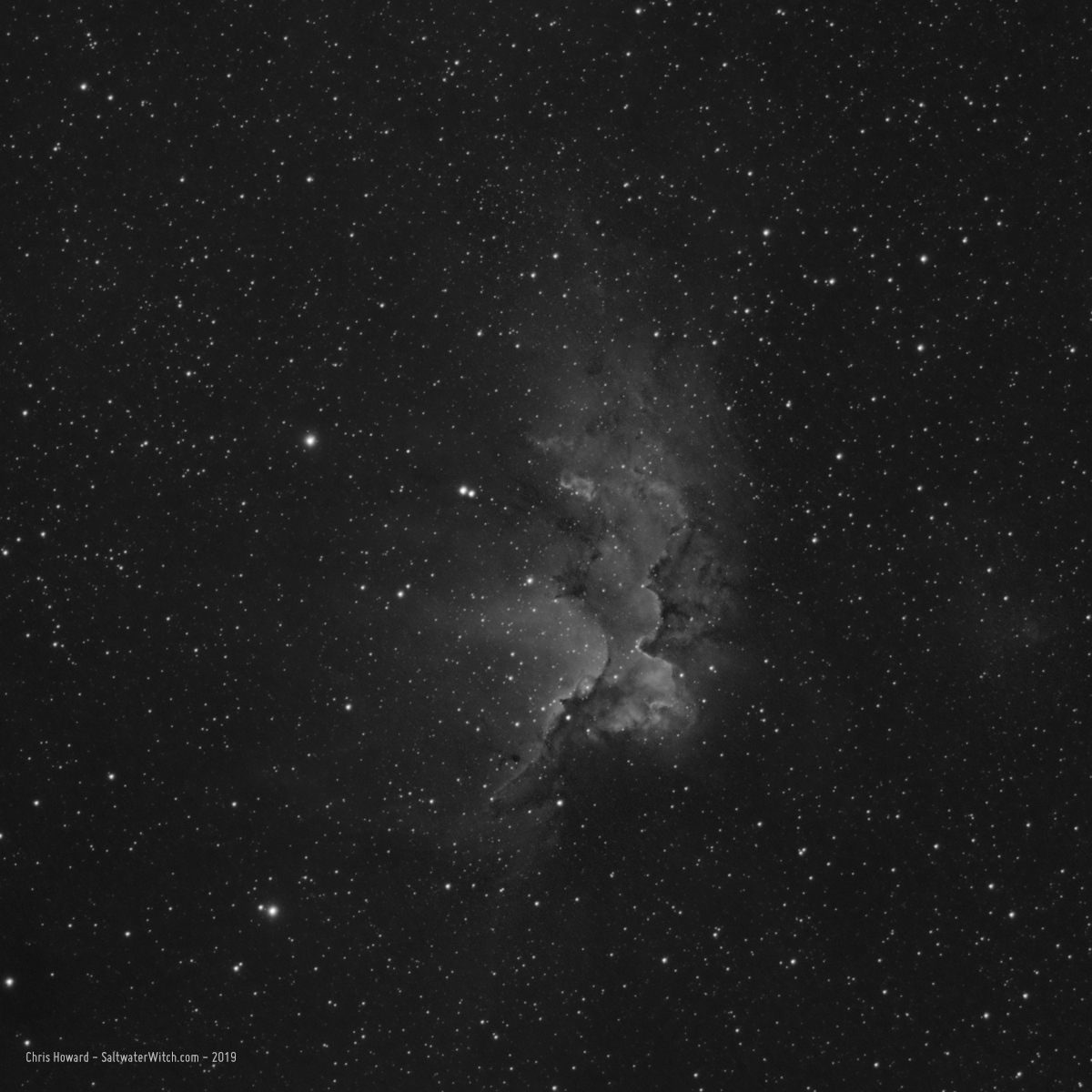
Sh2-54 Nebula and NGC 6604 open star cluster in Ha:

